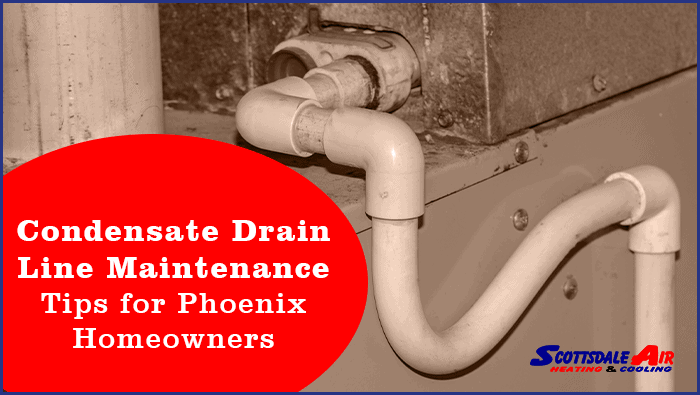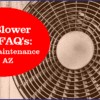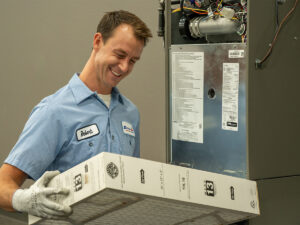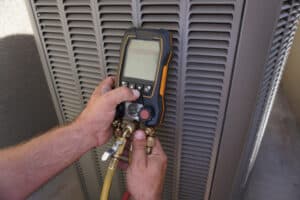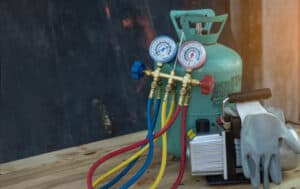It’s every Phoenix homeowner’s nightmare: in the middle of one of our record-setting summer days, your air conditioner suddenly shuts down and refuses to run.
There are few things more frustrating than unexpected HVAC issues, especially when you can’t figure out the culprit.
However, in many cases, the solution is a surprisingly simple one: your condensate drain line is dirty!
Your AC’s drain line is a critical part of your cooling system, and despite how strange it sounds, a little dirt and debris can sometimes shut down your entire unit.
Fortunately, knowing a few drain line maintenance tips and cleaning procedures can help you keep your AC running when you’re counting on it most.
Here’s what you need to know.
What Is Your Condensate Line, and Why Does It Matter?
As your air conditioner runs, it will produce moisture through its natural cooling processes.
Moisture Production: Your air conditioner naturally produces moisture during the cooling process.
Potential Problems: If moisture builds up, it can saturate your home’s air, creating a humid, sauna-like environment.
Health Risks: Excess moisture encourages the growth of mold and mildew, which can harm your health and damage your home.
System Damage: Accumulated moisture can also cause long-term harm to your air conditioning system.
Role of the Condensate Line: The condensate line prevents these issues by removing excess water from your air conditioner.
Functionality: This system efficiently drains moisture outside your home, keeping your indoor environment comfortable and your air conditioner running smoothly.
Why Is Condensate Drain Line Cleaning So Important?
As you might expect, any system that pulls moisture from one place to another is bound to get dirty over time.
Mold and mildew can build up if the system is left unchecked, and clogs caused by dirt and debris can keep the line from running as needed.
When your condensate line gets clogged, water can no longer run from your air conditioner to the exterior of your home.
It can cause water to leak from your indoor AC unit and into your home, damaging your walls and floors.
However, making condensate line cleaning part of your usual HVAC maintenance can keep the water’s path clear.
This, in turn, ensures that your cooling system runs in an efficient and clean manner.
How Do You Find Your Condensate Drain Line?
First things first: if you don’t know what your drain line looks like, locate it now.
In most AC brands, you can check for a white or copper pipe near your outdoor unit.
This is the end of your drain line, where water is released outside.
Inside, you should find a white PVC pipe with a cap on it near your indoor system. Most brands use gravity to make the water run down the line, but with some air conditioners, you will also see a small pump to help the moisture flow.
This capped pipe is your drain line access point, and it’s where you’ll be doing your cleaning.
What Drain Line Maintenance Tips Should You Follow?
If you’re going to tackle your own condensate line cleaning, there are a few basic maintenance tips to follow.
Shut Off Your AC and Grab Your Tools
If your condensate line is clogged, your HVAC system will automatically shut down. If you’re doing a routine cleaning and don’t have a clog, you’ll need to turn the system off on your own for safety.
Next, gather the tools you’ll need for the job. There are a few different options to choose from: a wet/dry vac, a garden hose, and vinegar or hydrogen peroxide.
Using a Wet Vac
If you have a wet/dry vac on hand, it’s often the easiest way to clear any obstructions.
If you don’t own one, you can rent one from a local home improvement store. Make sure you have a 3/4″ opening, which is the ideal size in most cases.
All you need to do is vacuum moisture and clogs from your condensate drain line.
Fix the hose attachment to the drain line with duct tape to seal the gap, and let it run for a few minutes.
Using a Garden Hose
This option is not as effective as a wet/dry vac in clearing away clogs, but it can be used in a pinch to clean your line.
You’ll want to follow the same steps as those above, connecting the hose to the access point with duct tape.
Run the hose to flush out the drain line.
Vinegar or Hydrogen Peroxide
If you don’t have the tools above, pouring either a cup of vinegar or a cup of hydrogen peroxide can help clean a drain line.
While this method won’t remove clogs, it can sometimes help them to break down enough to flow out of the system on their own.
Once you’ve poured the liquid in, wait 30 minutes, and finish up by flushing the system with water.
When Should You Contact a Phoenix HVAC Maintenance Specialist?
When Should You Contact a Phoenix HVAC Maintenance Specialist?
Most homeowners in Phoenix can handle cleaning their own condensate line, but there are certain situations where it’s better to call in a professional for AC maintenance. If you’ve tried to clear a clog in your condensate line but can’t, it’s time to bring in an expert. Additionally, if the condensate line appears clear but you’re still noticing signs of moisture—such as water leakage or stains on the ceiling—there may be another issue at play. This is especially concerning if you’ve observed higher humidity or moisture in the air. If you’re unsure, it’s best to contact a trusted AC maintenance company in Scottsdale, AZ, to diagnose and address the problem before it worsens. Regular annual HVAC maintenance ensures that a professional technician can clean the condensate line and tackle any issues during routine service, preventing potential problems in the future.
If you’ve tried to clean your condensate line but can’t clear a clog, get an expert to do the job for you.
Alternatively, if the condensate line seems clear but you’re still noticing signs of moisture—like water leakage or water stains on the ceiling—there may be another issue in play.
This is especially true if you’ve noticed higher humidity or moisture in the air, though you’ll want to rule out other common culprits as well.
Whatever the case, contacting the top ac company in Scottsdale AZ can help you diagnose the issue before it spirals any further.
Of course, if you undergo annual professional HVAC maintenance, you can let a technician tackle the cleaning for you as part of your routine service!
Trust Our Team With Your HVAC Maintenance
If you’re uncomfortable with cleaning your HVAC system on your own—or if you’re not sure what to do about a system shutdown—don’t sweat it out!
Scottsdale and Phoenix area homeowners trust our team to provide fast and efficient service when they need it most.
Whether you’re looking for a simple cleaning, top-to-bottom maintenance, or a last-minute repair, we’re here to help.
Contact us to learn what we can do for you, or request service today.

